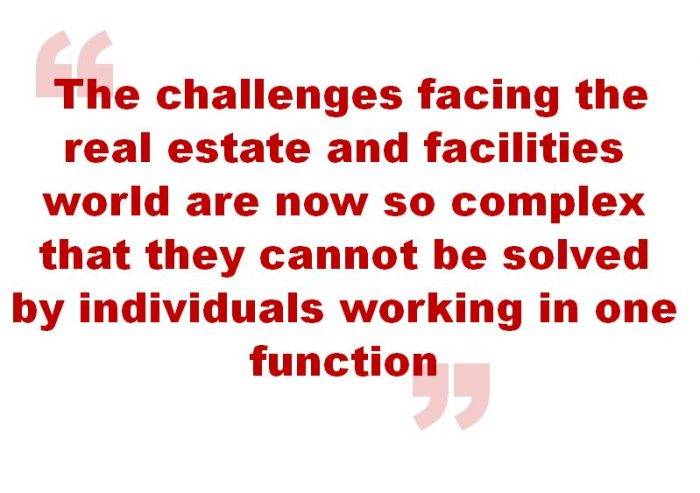 The natural world is a story of constant change and evolution. Animals, plants, insects and micro-organisms exist in an ecosystem, adapting to relentless changes in their environment, influenced by habitat, climate and their cohabitors. They respond to change faster than the human world, because they are not tied by the same restraints and conventions. They are interdependent and reliant on each other, competitors and cohabitors for mutual advantage. As humans move into what has been called the Fourth Industrial Revolution, there is much we can learn from nature, particularly within the workplace environment. The transformation of an organisation’s real estate, facilities management, IT and HR functions into a workplace ecosystem, as proposed by the Stoddart Review, has been discussed for some time.
The natural world is a story of constant change and evolution. Animals, plants, insects and micro-organisms exist in an ecosystem, adapting to relentless changes in their environment, influenced by habitat, climate and their cohabitors. They respond to change faster than the human world, because they are not tied by the same restraints and conventions. They are interdependent and reliant on each other, competitors and cohabitors for mutual advantage. As humans move into what has been called the Fourth Industrial Revolution, there is much we can learn from nature, particularly within the workplace environment. The transformation of an organisation’s real estate, facilities management, IT and HR functions into a workplace ecosystem, as proposed by the Stoddart Review, has been discussed for some time.
Most agree that removing the silos and turf wars between these support functions to better enable the organisation makes good business sense. The “why’, putting the workplace experience and productivity at the heart of business performance, has received a great deal of air-time. How to achieve this and what needs to happen in practice has received far less attention.
How the pieces are put together and processes structured is the key to success. Obviously every business will be slightly different, but ecosystem thinking can be applied to all. In a workplace experience ecosystem, the key is to bring together different stakeholders often representing different organisations with different points of view and to create a single vision and shared values. This will help the workplace experience to be aligned to strategy, increases effectiveness and, ultimately, improves the core organisation’s performance.
The IT guys will discuss the tech they’ll be bringing in. HR will talk about the impact of new labour law changes, for example, or how to support people adapting to remote working and new tech. FM will discuss implementing specific tech such as workplace sensors or how cleaning/ catering or security regimes might need to adapt to accommodate change in the business. All these different stakeholders collaborating proactively towards a common goal rather than working in silos and indulging in turf wars. Unleashing the potential for accelerating performance improvement will enable organisations to recognise the ecosystem as a key engine of future performance and move beyond the notion of high performing individuals or teams. Business ecosystems are seen by many commentators as an opportunity for creating powerful new competitive advantage.
Creating a workplace ecosystem
Continual change is one of the fundamental laws of nature and just as the animal kingdom is constantly adapting, we as humans, are living in an era of unfathomable change. Technology-driven advances are happening at an exponential rate, changing our habitat and with it the very fabric of society. Everything we do is becoming enabled and enhanced through new technology, apps and intelligent machines. To survive and thrive in this new digitally-enabled, consumer and experience-driven world, businesses need to completely rethink how and where they supply their product, service or value proposition. Manufacturers, service providers and retailers will have to reinvent themselves to compete effectively in a rapidly-changing, highly-demanding world.
The old corporate-centric models with rigid hierarchies, silo mentality and traditional business strategies are slow to respond and are rapidly becoming disconnected with today’s world. We need to be bold enough to break conventional methodology to form new alliances and strategic partnerships, way beyond the concept of the simple outsourced models of the last five decades.
 What is required in the new world are dynamic networks made up of a much wider range of internal and external specialist contributors; working with a shared vision and interacting with each other to create and exchange sustainable value for all participants. Each entity benefiting from the co-creation of value and co-evolving. Such value co-creation drastically increases innovation and the impact of a product or service, ultimately boosting core organisation performance.
What is required in the new world are dynamic networks made up of a much wider range of internal and external specialist contributors; working with a shared vision and interacting with each other to create and exchange sustainable value for all participants. Each entity benefiting from the co-creation of value and co-evolving. Such value co-creation drastically increases innovation and the impact of a product or service, ultimately boosting core organisation performance.
The challenges facing the real estate and facilities world are now so complex that they cannot be solved by individuals working in one function. What is needed are groups of interrelated subject matter experts working together in cohesive workgroups or ecosystems to co-create value and co-evolve into a highly effective one team solution. Today’s businesses need strong support functions – real estate, facilities management, IT and HR – sharing the same values and working collaboratively together to solve these challenges. Not working in silos and developing disconnected service offerings.
An article in Harvard Business Review by James Moore looked at how in an increasingly dynamic and interconnected world of commerce, the successful businesses are those that evolve rapidly and effectively. “They must attract resources of all sorts, drawing in capital, partners, suppliers, and customers to create cooperative networks In a business ecosystem, stakeholders co-evolve capabilities around a new innovation: They work cooperatively and competitively to support new products, satisfy customer needs, and eventually incorporate the next round of innovations.” What value could be created by adopting this ecosystem model in the workplace arena?
Getting the right infrastructure
Traditionally, people have seen competitors as rivals who battle each other for dominance and profit. The same can be said of support functions who battle each other for share of a budget and the ear of the board. Today’s organisations operate in a more complex world. They compete and cooperate in innovative and unexpected ways and they need each other in order to survive. This is the new world of business ecosystems.
It is about designing the organisation structure around the purpose of the organisation and putting the customer at the centre. Every business will be slightly different and structure this differently. But with the creation of a workplace experience ecosystem, there will be different stakeholders with different points of view all focusing on the same goal – making the workplace experience the best it can be, enabling improved business performance.
The IT experts will discuss the latest technology they’re introducing. The HR specialists will talk about the impact of new labour law changes, for example, or how to support people adapting to changes in how and where work is done. The FM professionals will look at how cleaning/ catering or security regimes might need to change to accommodate workplace sensors. And the real estate experts will focus on how the property footprint might need to change to adapt to the latest changes in the business. Rather than these functions all working separately, and often duplicating work and not sharing information, they will all work together in One Team delivering an outstanding workplace experience to the core business.
Some might argue that the HR team, for example, will have subject-specific work that does not involve other specialisms. But this is not the case. A new training programme, changes in headcount, a wellbeing drive and new legislation all affect the workplace experience. As does an upgrade in technology infrastructure introduced by the IT team. Whichever way you look at it, the real estate, FM, IT and HR functions work better in a workplace ecosystem where they are focused on delivering the core needs of the business.
Key to success is an operating platform that gives the ecosystem structure, defines system and processes (especially for knowledge sharing and innovation) and aligns input and output to a common goal (purpose).
The steps to forming an effective workplace ecosystem are easy to define, but much harder to initiate. It requires business leaders to break free from the traditional corporate models and embrace a whole new way of working. Those who don’t prepare now for the next great wave of transformation will be left behind.
Image: The devil takes the hindmost. An illustration from Joseph Glanvill’s Saducismus Triumphatus
_______________________________
 Bruce Barclay is a facilities professional and experienced international speaker as well as author of the BIFM’s Good Practice Guide to Managing FM Teams Across Borders. He is a member of the International Facility Management Association (IFMA), CoreNet Global, the British Institute of Facilities Management (BIFM), and past member of the Building Owners and Managers Association (BOMA) and Chartered Institution of Building Services Engineers (CIBSE). He can be contacted here.
Bruce Barclay is a facilities professional and experienced international speaker as well as author of the BIFM’s Good Practice Guide to Managing FM Teams Across Borders. He is a member of the International Facility Management Association (IFMA), CoreNet Global, the British Institute of Facilities Management (BIFM), and past member of the Building Owners and Managers Association (BOMA) and Chartered Institution of Building Services Engineers (CIBSE). He can be contacted here.












January 31, 2019
Get ready for the next wave of technological innovation, or get left behind
by Bruce Barclay • Comment, Facilities management, Property, Technology
Most agree that removing the silos and turf wars between these support functions to better enable the organisation makes good business sense. The “why’, putting the workplace experience and productivity at the heart of business performance, has received a great deal of air-time. How to achieve this and what needs to happen in practice has received far less attention.
How the pieces are put together and processes structured is the key to success. Obviously every business will be slightly different, but ecosystem thinking can be applied to all. In a workplace experience ecosystem, the key is to bring together different stakeholders often representing different organisations with different points of view and to create a single vision and shared values. This will help the workplace experience to be aligned to strategy, increases effectiveness and, ultimately, improves the core organisation’s performance.
The IT guys will discuss the tech they’ll be bringing in. HR will talk about the impact of new labour law changes, for example, or how to support people adapting to remote working and new tech. FM will discuss implementing specific tech such as workplace sensors or how cleaning/ catering or security regimes might need to adapt to accommodate change in the business. All these different stakeholders collaborating proactively towards a common goal rather than working in silos and indulging in turf wars. Unleashing the potential for accelerating performance improvement will enable organisations to recognise the ecosystem as a key engine of future performance and move beyond the notion of high performing individuals or teams. Business ecosystems are seen by many commentators as an opportunity for creating powerful new competitive advantage.
Creating a workplace ecosystem
Continual change is one of the fundamental laws of nature and just as the animal kingdom is constantly adapting, we as humans, are living in an era of unfathomable change. Technology-driven advances are happening at an exponential rate, changing our habitat and with it the very fabric of society. Everything we do is becoming enabled and enhanced through new technology, apps and intelligent machines. To survive and thrive in this new digitally-enabled, consumer and experience-driven world, businesses need to completely rethink how and where they supply their product, service or value proposition. Manufacturers, service providers and retailers will have to reinvent themselves to compete effectively in a rapidly-changing, highly-demanding world.
The old corporate-centric models with rigid hierarchies, silo mentality and traditional business strategies are slow to respond and are rapidly becoming disconnected with today’s world. We need to be bold enough to break conventional methodology to form new alliances and strategic partnerships, way beyond the concept of the simple outsourced models of the last five decades.
The challenges facing the real estate and facilities world are now so complex that they cannot be solved by individuals working in one function. What is needed are groups of interrelated subject matter experts working together in cohesive workgroups or ecosystems to co-create value and co-evolve into a highly effective one team solution. Today’s businesses need strong support functions – real estate, facilities management, IT and HR – sharing the same values and working collaboratively together to solve these challenges. Not working in silos and developing disconnected service offerings.
An article in Harvard Business Review by James Moore looked at how in an increasingly dynamic and interconnected world of commerce, the successful businesses are those that evolve rapidly and effectively. “They must attract resources of all sorts, drawing in capital, partners, suppliers, and customers to create cooperative networks In a business ecosystem, stakeholders co-evolve capabilities around a new innovation: They work cooperatively and competitively to support new products, satisfy customer needs, and eventually incorporate the next round of innovations.” What value could be created by adopting this ecosystem model in the workplace arena?
Getting the right infrastructure
Traditionally, people have seen competitors as rivals who battle each other for dominance and profit. The same can be said of support functions who battle each other for share of a budget and the ear of the board. Today’s organisations operate in a more complex world. They compete and cooperate in innovative and unexpected ways and they need each other in order to survive. This is the new world of business ecosystems.
It is about designing the organisation structure around the purpose of the organisation and putting the customer at the centre. Every business will be slightly different and structure this differently. But with the creation of a workplace experience ecosystem, there will be different stakeholders with different points of view all focusing on the same goal – making the workplace experience the best it can be, enabling improved business performance.
The IT experts will discuss the latest technology they’re introducing. The HR specialists will talk about the impact of new labour law changes, for example, or how to support people adapting to changes in how and where work is done. The FM professionals will look at how cleaning/ catering or security regimes might need to change to accommodate workplace sensors. And the real estate experts will focus on how the property footprint might need to change to adapt to the latest changes in the business. Rather than these functions all working separately, and often duplicating work and not sharing information, they will all work together in One Team delivering an outstanding workplace experience to the core business.
Some might argue that the HR team, for example, will have subject-specific work that does not involve other specialisms. But this is not the case. A new training programme, changes in headcount, a wellbeing drive and new legislation all affect the workplace experience. As does an upgrade in technology infrastructure introduced by the IT team. Whichever way you look at it, the real estate, FM, IT and HR functions work better in a workplace ecosystem where they are focused on delivering the core needs of the business.
Key to success is an operating platform that gives the ecosystem structure, defines system and processes (especially for knowledge sharing and innovation) and aligns input and output to a common goal (purpose).
The steps to forming an effective workplace ecosystem are easy to define, but much harder to initiate. It requires business leaders to break free from the traditional corporate models and embrace a whole new way of working. Those who don’t prepare now for the next great wave of transformation will be left behind.
Image: The devil takes the hindmost. An illustration from Joseph Glanvill’s Saducismus Triumphatus
_______________________________